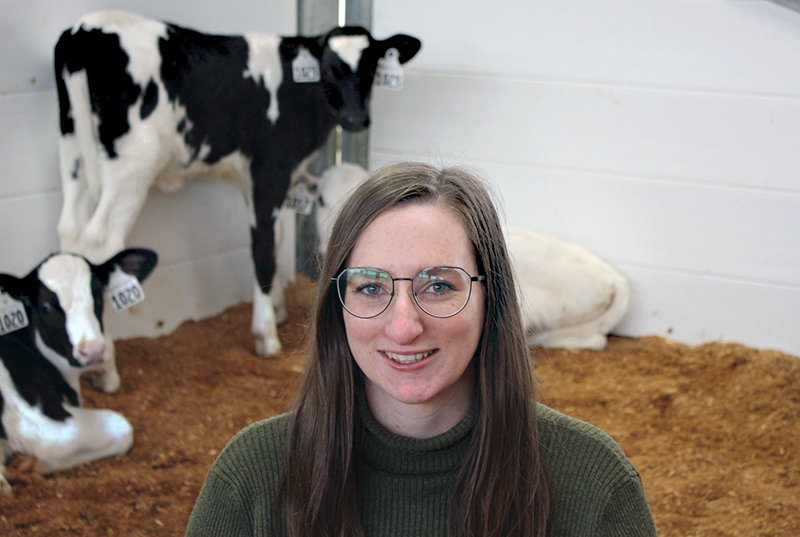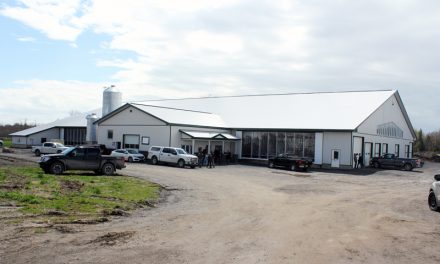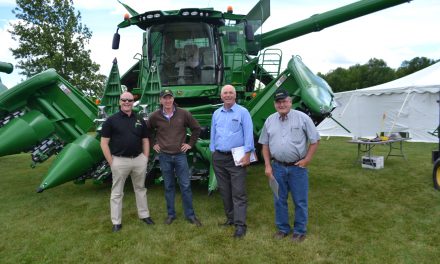Allison Welk, a M.Sc. student in the animal welfare program at the University of British Columbia was the winner for her presentation. Courtesy Photo
By Vanessa White
AgriNews Contributor
The Western Canadian Dairy Seminar Student Competition is an opportunity for top students in the agricultural industry to present their research to dairy producers.
When speaking with Allison Welk, a M.Sc. student in the animal welfare program at the University of British Columbia, it is easy to see why she was the winner for her presentation. She researched the effect of individualized weaning methods and forage types on dairy calf behaviour and performance. She is enthusiastic, knowledgeable, practical and quietly confident when speaking about her research. The winning presentation was selected by producers attending the conference and is available to view on YouTube.
When Welk was doing her undergraduate degree in environmental studies at Dalhousie University, it felt like she was heading in the opposite direction from where she grew up, on a hog farm in Marvelville, Ont. Her post-graduate studies, however, have brought her back to her roots in the agricultural industry, as she studies applied animal biology at the University of British Columbia.
As a teenager, Welk worked on dairy farms in the Russell and Metcalfe area where she gained practical knowledge of the dairy industry. And then after her undergrad she returned to work on dairy farms, but more in herd management than as a general labourer. During this time, she became more and more interested in how to improve methods in the industry and these experiences have shaped her education and research choices.
Welk chose to focus her research project on calf weaning and feeding because she had noticed that farmers often faced challenges in this area. The most common criterion for weaning calves is age and she pointed out that this can be problematic if calves are not consuming enough solid feed. Calf stress and poor weight gains can result from weaning too early or poor feeding practices. Welk summarized, “The point of intake-based weaning is to only start weaning calves when they are actually consuming solid feed; it is a way to individualize weaning for each calf.”
During the project, several groups of calves were compared. The groups were given different treatments and one group was weaned based on solid feed intake and another based on age. The group that was weaned based on intake instead of age had overall higher feed intake and weighed more at the end of the study period. According to Welk, “Overall I think weaning based on intake should result in better growth and better feed intakes compared to weaning calves based on age.”
A major challenge for producers wanting to implement this type of weaning is because many farmers manually feed and use individual housing for calves. Although automatic calf feeders that monitor calf milk and feed intake are used on some farms, currently there isn’t a software program developed to easily customize the milk ration according to solid feed intake.
The research also compared feeding different forage types to calves. Other recent research has indicated benefits to feeding forage in addition to grain. The industry has not fully embraced this yet with some producers preferring to feed only grain.
In comparing the addition of grass hay versus silage based TMR, Welk’s research indicated that grass hay was better initially, with greater gains at weaning time because of increased dry matter intake. However, as the animals were followed for a 5-month period, calves fed TMR bridged the growth gap and there was no difference between the two treatment groups.
Although she was careful to say that her findings are not definitive, Welk is confident there are several things that producers may find easy to implement. One is to increase milk volume (eight to 12 litres of milk) and offer forage as well as grain. Another is to delay weaning until at least eight to 10 weeks and then do it gradually over a two-week period using a step-down method.
One of the questions raised by the study is to find out why 10 per cent of the calves ‘failed.’ Several calves did not meet the required solid feed intake target before nine weeks and therefore were force-weaned instead. These calves weighed significantly less at the end of the 10-week period and further research is required to find out why they struggled so much. Monitoring feed intake is a method that farmers can use to identify struggling calves.
As well as advocating for further improvements to calf feeding, Welk mentioned several times the positive changes already seen in the industry over the last few decades. Some producers are already weaning at ten to 12-weeks and feeding higher quantities of milk. Welk has other ideas to further study this topic and the industry will certainly benefit from her keen and inquisitive mind.













